Sarah Crouch, Head of Publishing and Content at the Royal Institution of Chartered Surveyors, shares the challenges and successes of implementing an automated publishing workflow at the 2018 Typefi User Conference.
Transcript
SARAH CROUCH: Hello everyone. It’s a pleasure to be here. I’m not as confident as some of the other speakers, so I’ve got myself a little script which I’ll try not to use but please bear with me.
I’m delighted slash a bit terrified to present to you today, and talk you through our Typefi journey.
So, introduction, a little bit about me to start with. I’ve been working in publishing for about 15 years. I’ve been at RICS for about eight of those years.
About five or six years ago—my main background is in editorial by the way, so, editorial and production and XML, XPP, SGML, all that sort of thing—and about five or six years ago, I went for an interview at BPP, when they wanted somebody to head up their new XML venture.
Quite glad I didn’t get that job because it sounds like it might have been a bit of a headache.
So, I now head up what we slightly cringingly call the Publishing Centre of Excellence at RICS, and we produce standards, isurv, which is our online information service, journals, and we’ve also produced some Insight papers which is sort of thought leadership, white papers.
We’ve been using Typefi for about two years, two and a half years. Although, I like to say we’ve been using it, because we’ve had quite a few struggles and challenges which I will come on to.
About RICS
So, before I get into that, I’ll just tell you a little bit about RICS and who we are, what we do. We’re the Royal Institution of Chartered Surveyors.
We get told off if we call ourselves ‘ricks’, because that sounds a bit like a greasy spoon. And we’re not supposed to call ourselves the Royal Institution either because we’re now meant to be a global brand.
But we were established back in 1868 and we promote and enforce standards in land, real estate, construction and infrastructure.
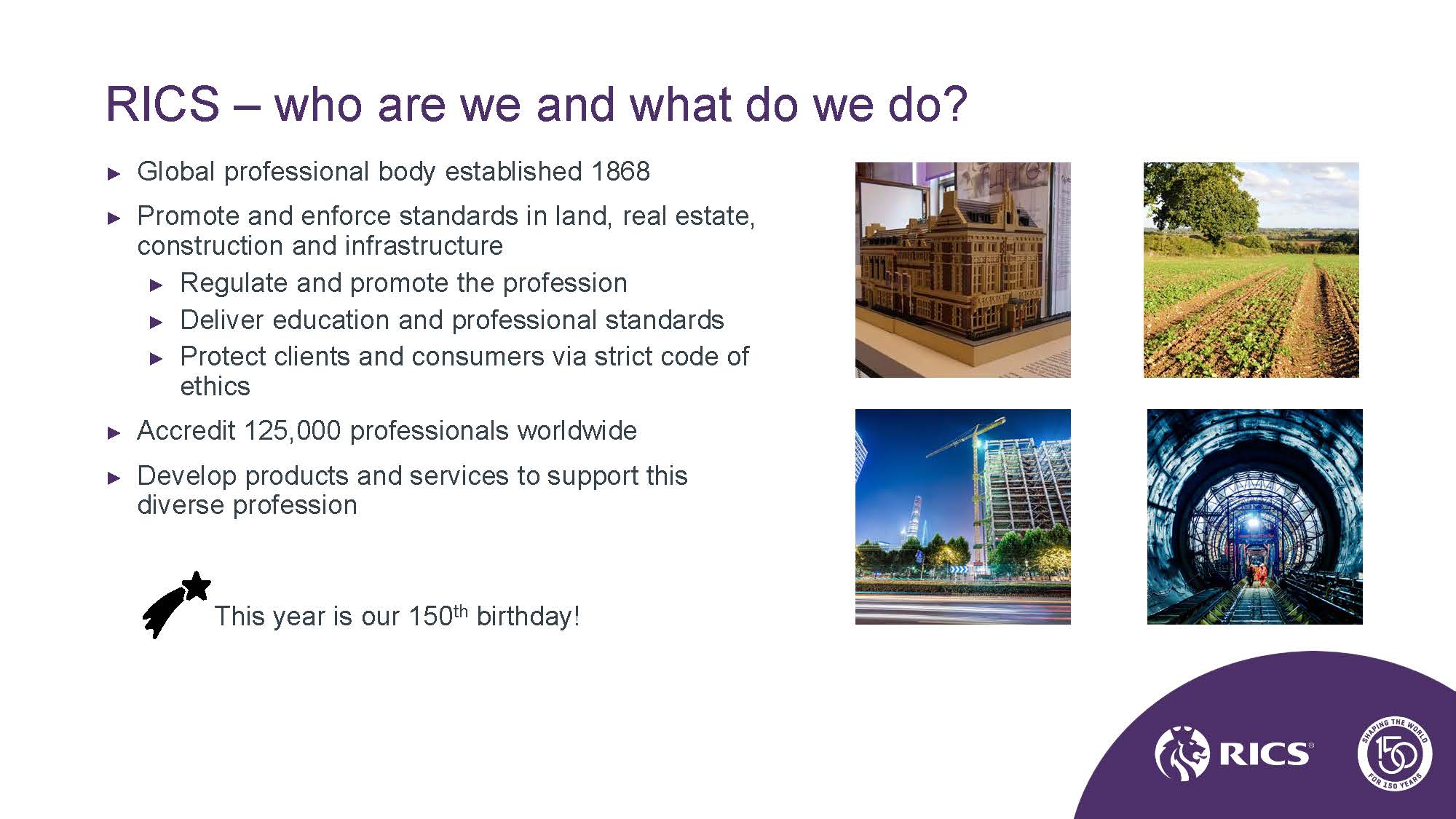
We do all those things there that it says in the bullets and on the top left-hand side you can see a picture of our HQ building which is made out of LEGO for our 150th anniversary. And it’s mainly there just because I think it’s quite cool.
So, we accredit 125,000 professionals worldwide. I’m sure most of you have heard of surveyors through buying your homes or you might think a quantity surveyor counts bricks and drinks tea because why wouldn’t you? But it’s actually a very diverse profession.
Our members save the taxpayer and their clients millions of pounds by mitigating risks and controlling costs on construction projects and things like that, so offer quite a valued service to society.
Core publications
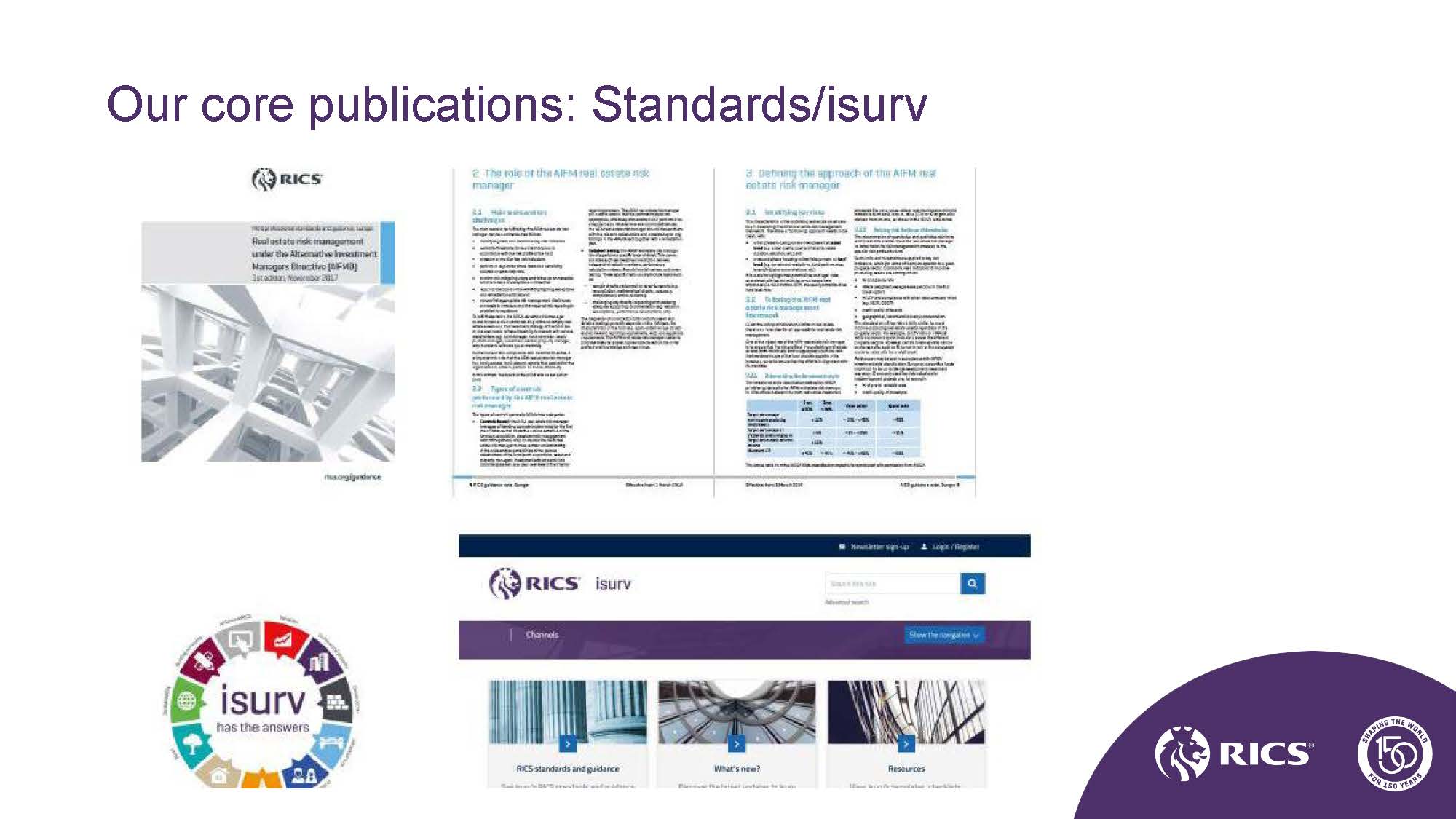
Our core publications, and sorry for the slightly rough quality of these screen shots, but in the top, you’ve got standards. That’s the cover and that’s the inside pages but doesn’t really work very well on here.
But standards are the lifeblood of our business, really, it’s the core of what we do. We publish about 20 or so a year. Some of them are also translated into various different languages. And standards are the main reason that we’re interested in Typefi, which I’ll come to in a bit.
isurv is our online information service, as I mentioned, and that product is pretty much exclusively maintained by our relatively small editorial team.
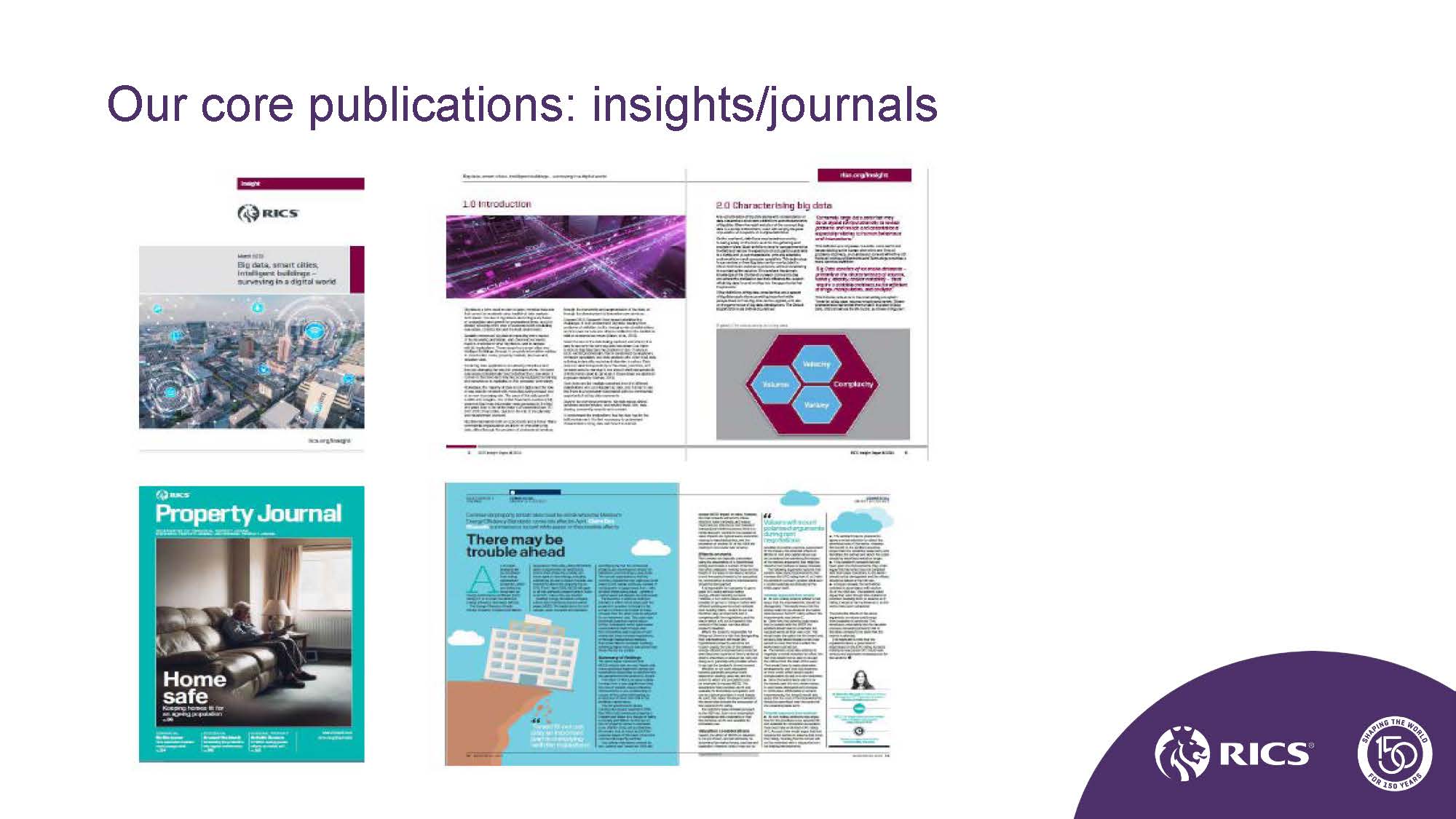
We’ve then got Insights, which are, as I said, the thought leadership reports. They look quite similar to standards but they’re a bit more interesting in terms of the layout, and we’ve just started to Typefi them, which is cool. I think we’ve done about two now.
Then at bottom, as I mentioned, we’ve got our journals as well but for the purposes of today, I won’t be talking too much about journals because they’re quite magazine-y in their layout, so they’re not quite suited to Typefi yet, but in the future, who knows?
The RICS publishing team
So, I’m going to talk a bit about our editors because they’re pretty much the epicentre of RICS. There wouldn’t really be any publications without them and they pretty much do everything.
It looks like a fairly large team but with the amount that we do, it’s not as big as it looks. We’ve got two team leaders, Jo and Sean, who are both here. Jo’s in our Coventry office and Sean is in our London office in Parliament Square.
And then, we’ve got five editors split between Coventry, soon to be Birmingham, and London, and we’ve got one journal sub-editor who does the journals and doesn’t really use Typefi.
But our editors really do do pretty much everything, especially when it comes to the standards and isurv. They edit the content, they manage the authors, they do the InDesign work, image research. They do all the Typefi-ing, the template work, and then there’s all the CMS stuff that goes into maintaining isurv as well.
So they do, like I said, they do everything. They do a bit of coding, they do a bit of firefighting. They really do offer a valued service to RICS, and my background is pretty much all editorial so I’m slightly biased as well.
In terms of working in an institution like RICS, we do have our challenges. So, for one thing, publishing just isn’t our core business. We’re a relatively small publishing team in a non-publishing company.
So, people just don’t have a clue what we do, to be honest. And why would they? I don’t really know what it takes to value a house but there is a lack of understanding and I’d go so far as to say, a lack of respect, quite a lot of the time, towards us. So, that has its frustrations.
Our authors are serial non-deliverers. They don’t understand things like deadlines and contracts and why do I have to read stuff? They don’t follow processes.
A lot of our authors are internal as well. So, people don’t follow processes and it’s usually ‘something has to publish on this date’ and it’s usually down to the editors to make up the time and try and pull it back. And to our credit, most of the time, we do.
As I mentioned earlier, we take on a lot of projects. We work on multiple things at any one time, so there’s a lot of juggling. So, people do underestimate our ability to be able to do things quickly because we’re constantly having to prioritise and reprioritise and manage our output that way.
And then there’s a bit of a lack of awareness of outputs. So, we just get people randomly saying, “Oh, can we publish this in XML or can we have this as an app?”
But they don’t really know what kind of app they want or why they want an app, they’ve just heard of apps, so they think we should do them. So then I have to kind of explain to them that, you know, “Why do you want this? Do you really? No, okay.”
And as I’ve sort of hinted at, there’s quite a lot of internal politics, which I won’t get into too much. We’re a fairly siloed organisation, it’s getting a little bit bigger.
But yeah, it has its frustrations, which are not great for things like productivity.
And we’ve also got some commercial pressures as well and conflicting priorities. So, we’re not a money-making organisation. We get most of our revenue from membership subscription fees.
And our standards—most of our publications, actually—are just free online now, to anybody that wants to see them. You’re all very welcome to have a look later on.
But then, I’m always asked, “Why can’t we make our standards more profitable? Why can’t we sell things?” Well, people don’t want to pay for things when they can get a pretty good version of it for free, essentially.
So, those are some of the challenges of where we work but it’s also quite fun. So, what I like about working in RICS is that it’s a smaller team.
My previous company, I was working at a legal publisher with about 40 editors and doing the same job, so you’re just a cog, essentially, and everyone’s doing the same thing and there’s no kind of room to grow or develop or be creative.
So, in my current role, I do have the chance to do some of that. And that’s what eventually led me to Typefi.
RICS and Typefi
So, as Chandi mentioned, I think we first met the team in, I think, 2015 or something like that.
I’d been researching new production methods, because previously, we’d been using XML, with a third-party XPP provider who held all of our templates, which I’m sure you’re all familiar with, and that was just becoming increasingly clunky and frustrating.
We didn’t really have any control over our templates. Our suppliers were a tiny operation of two part-time people who just weren’t really providing us with a very good service anymore.
And you guys probably know a lot more than I do, but the world’s moved on since XPP and people aren’t really doing that anymore, so we needed a way to future-proof our business and our products.
So, one thing we tried a few years ago was InDesign. We had a new team member who was like, “Hey, yeah, InDesign is really cool and we can save loads of money and do everything in-house.”
But that had its disadvantages as well, where there was quite a lot of manual work involved, which is fine for a 20-page standard but for a 300-page book, isn’t the greatest.
And it’s easy to introduce errors in InDesign as well, so we had a publication only couple of months ago where the editor randomly decided to use an old InDesign template and just update it and there were a couple of errors of the page furniture and I kind of said, “Actually, that wouldn’t happen if we’d used Typefi.”
So, why we use Typefi is that we needed to be more efficient in our production. We have different editors using different methods, so some would use XML just because they preferred it, someone would use InDesign just because they preferred it or they felt like using it on the day.
For business continuity and things like that, it wasn’t the best and Typefi seemed to take the best bits of each, so that seemed to work well for us.
There was the potential for smarter content, so things like EPUB and accessibility, and yeah, we could make money by selling EPUBs and things like that, which we’re not quite doing yet, which I’ll come to in a bit.
But we also liked it because it was scalable—there were potential benefits for other areas of the organisation.
As I mentioned, we’re a little bit siloed, so we’ve got various different pockets of content creation and publication and they don’t all come under the Publishing Centre of Excellence just yet but we’re working on it and we’ve recently got the Insights, so that’s quite good.
The other thing we liked about Typefi was, again, business continuity. So, less reliance on legacy technology, suppliers who just didn’t really want to do anything for us anymore. And it’s much easier to train new editors.
So, that all sounded really good until we came across something called the Procurement Black Hole.
This started the day that we were due to have our training—the editors had all come to London from Coventry, Guy had flown over from Amsterdam and we were going to spend four days together, having fun with Typefi and creating templates and learning lots and, well, generally having a great time.
I think it was that day that we found out that Typefi wasn’t actually compatible with our IT infrastructure because we were all on—I don’t know what the term is, we called them Wyse boxes— and for us to have the plug-ins installed, I think everybody in the whole company would have to have the plug-ins installed.
I think we found a workaround on that day and went ahead with the training. But then, RICS being RICS, it took I think another six or seven months before we actually had the software. And the answer to that was just give us laptops and now they give everyone laptops as standard, so that’s all good.
But it was very frustrating that, like I said, six to seven months passed, and so by the time we actually were able to use Typefi, we couldn’t really remember anything. But we did our best. And I think we had one or two refresher sessions with Guy. Thank you for those.
Once we’d got the hang of it, it started to work out quite well. I think our first publication that we ran through Typefi eventually launched in January 2017.
We’ve now run, I think, 21 publications through the system, which I worked out was 18 standards, and that’s about 75% of the standards we’ve published overall. There were five or six where the design was just a bit too complex, so we went with InDesign for those. Two Insight papers and one APC guide, which we’ve done for another team.
So, that’s really great for us, especially the second two, because those were previously typeset by really, really expensive design agencies, so we were able to save some cash for the wider organisation which is nice.
But we do have some challenges. I’ll talk a bit about the positives, which I’ve mentioned—the team is self-sufficient in both Writer and Designer, saving some money, which is great.
Happy editors—I added the question mark about an hour ago, because the discussion we were having over lunch is that Typefi’s had a bit of a Marmite reaction with our team.
Some people do seem to really like it and I’ve got some quotes from the team coming up, so they can essentially tell you themselves. But I think Jo or Sean, just now, kind of said, yeah, it doesn’t suck as much as it used to.
So, I’m still working on them because I really like Typefi. And I still like the fact that it’s got a lot of potential for us, and areas that we’re yet to explore.
So, I will talk about the niggles and there are a few, the first being EPUB and the question mark is there because I think that’s more on us than it is on Typefi.
It was one of the things that really attracted us to Typefi, that we wanted to be able to produce EPUB, partly to tick our accessibility box but also because we thought we could make money.
So, we’ve now got the ability to publish e-books and produce them, but what we don’t have are customers that actually want them and even if they did, we don’t have the ability to sell or distribute them because that goes back to the point about siloed working in different systems that just don’t talk to each other.
There’s quite a lot of investment that’s needed in our internal systems and procurement and things like that. So, still trying to work on the EPUB solution but because we’re not really getting any demand, that’s kind of put on the ‘later’ pile.
Column balancing. So, we’ve got a fairly simple, I think, two-column layout for our standards and our Insights.
All we really, really want to do is kind of have the column on the right, the same length as the column on the left, to make it look a bit tidier. But the way that it works for us, is that it either does that or it kind of balances even the smallest amount of text.
I think Guy and the team have been looking for a solution for us and we think we might be ready to do something with Typefitter now at some point, but yeah. That’s been something that’s been a bit of a bugbear for us.
Images. People don’t like using Typefi for images. It’s almost as bad as when we used to use XML and XMetaL with all the trial and error that goes with it, especially with floating elements and just getting things to appear on the page where you want them.
Same thing for tables, because we have quite a few lengthy, complex tables. So, if any of you guys use Typefi and have lots of complex tables and images, please get in touch with me and help us because yeah, that would be really good to sort that, because I think it would help make the team a bit happier.
The other thing we’re not sure about is indexing. But we’ve only got about two books now because most of our books are online, so it’s not a huge issue, but if we could do something with that, that would be nice.
So, I’ve got a few quotes here from members of the team. Most of them are quite positive, because I told them to be.
(Audience laughs.)
I didn’t really. I don’t think I need to read them out to you, I’ll just give you time to read them.
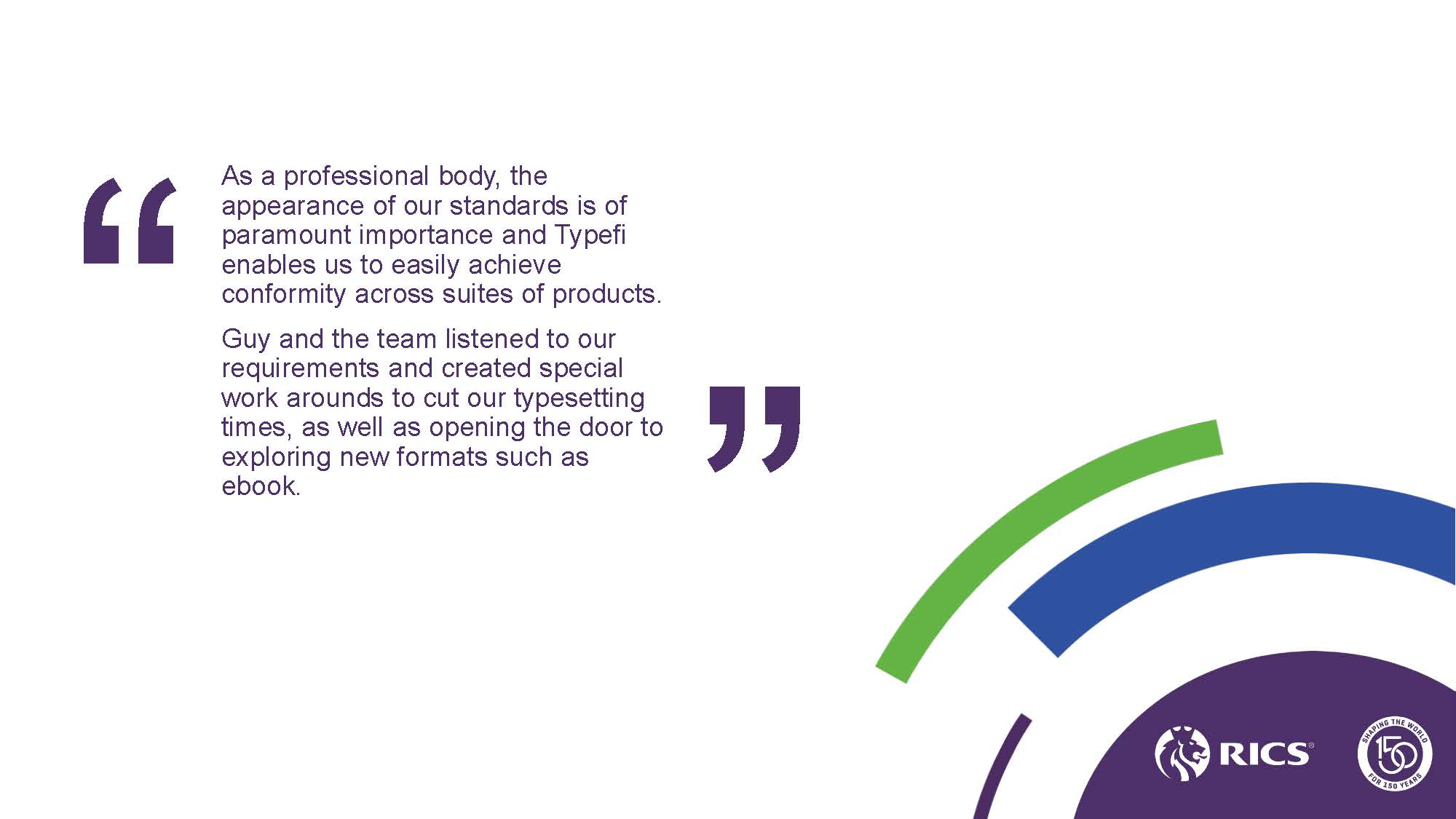
This is a nice one because it’s short.
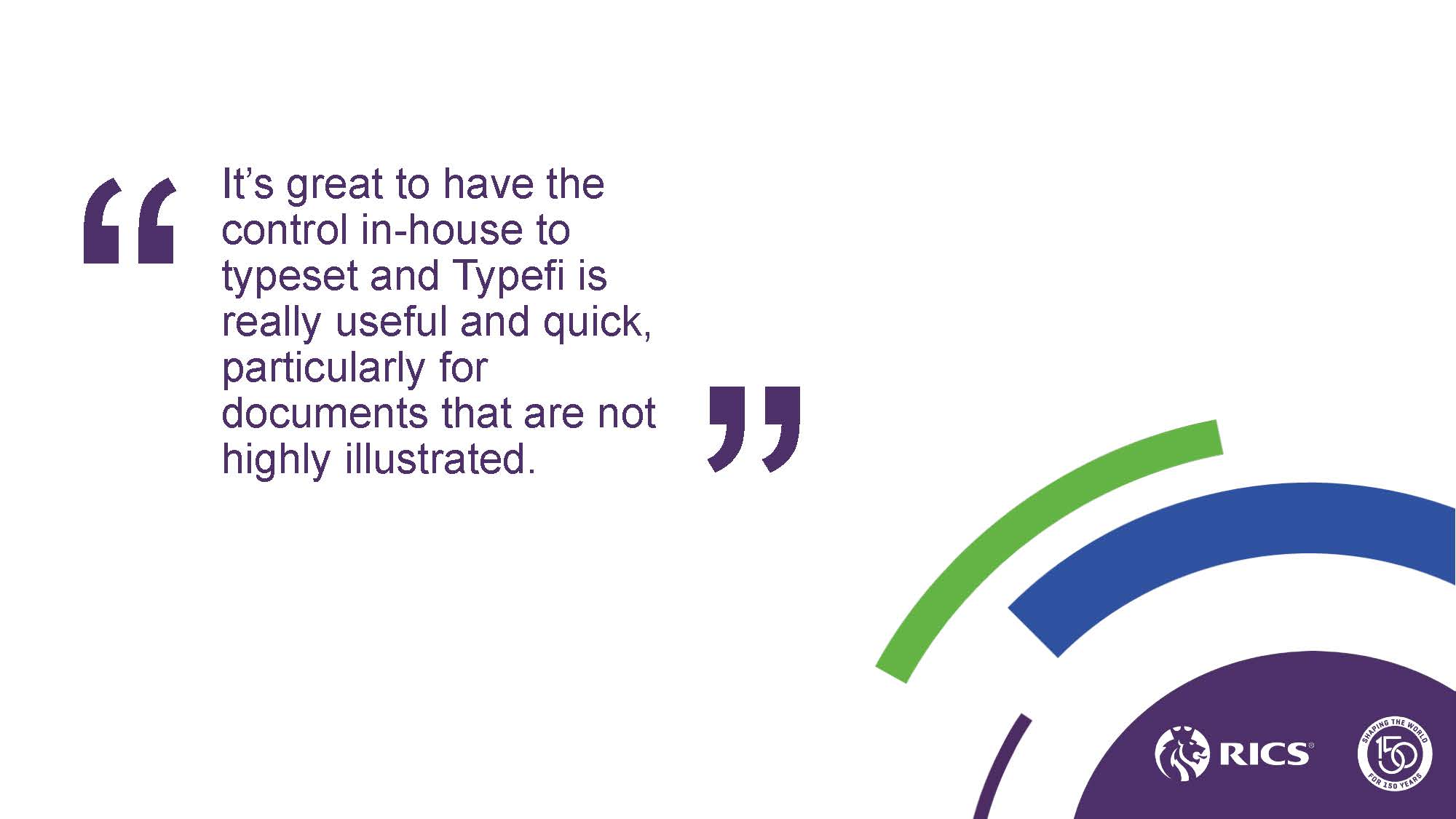
Yeah, this is a positive one, I think, from one of our super users who is quite into Typefi but she’s still kind of one of the few for now.
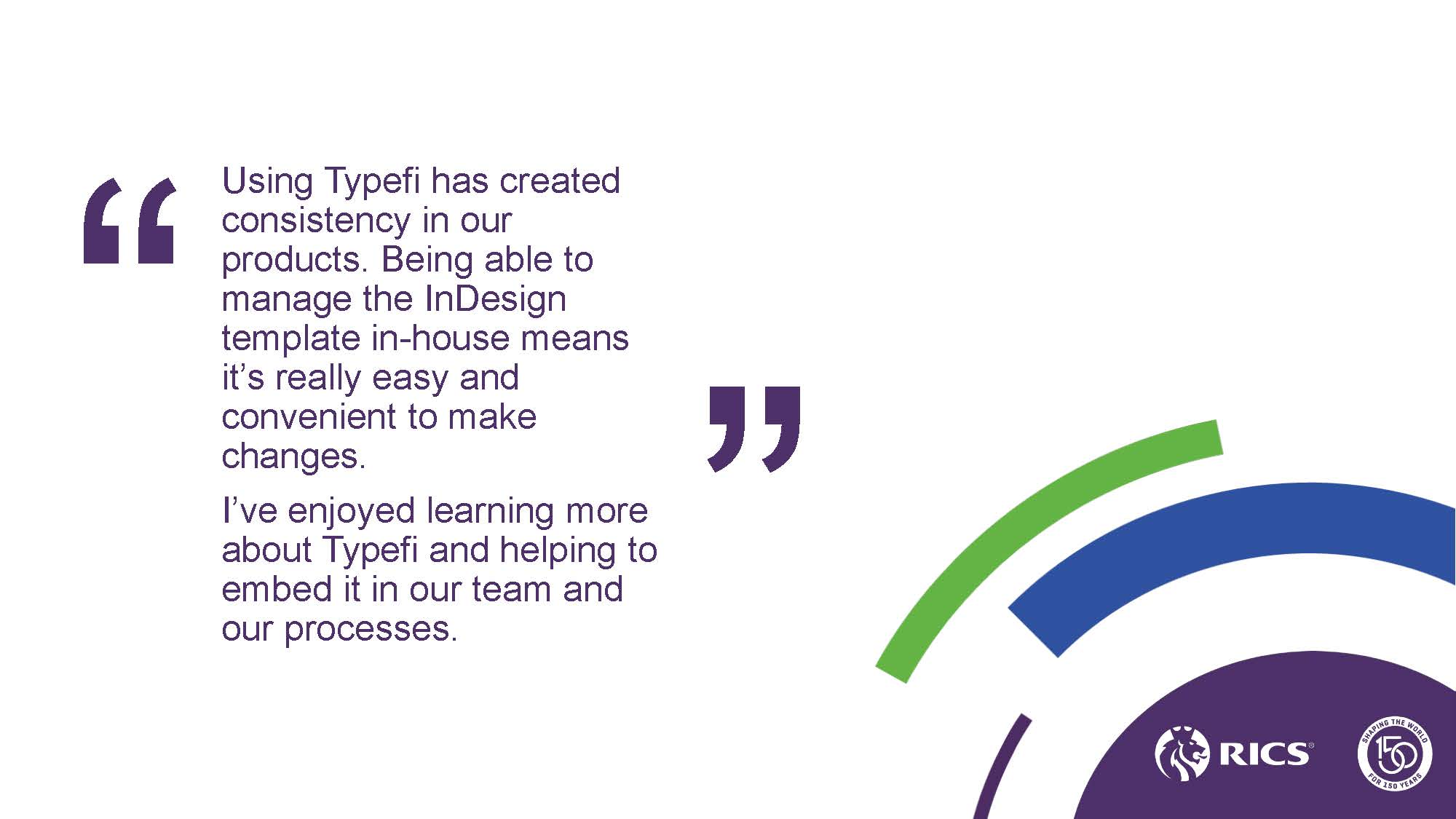
And yeah, somebody being very honest here about column balancing and inserting images.
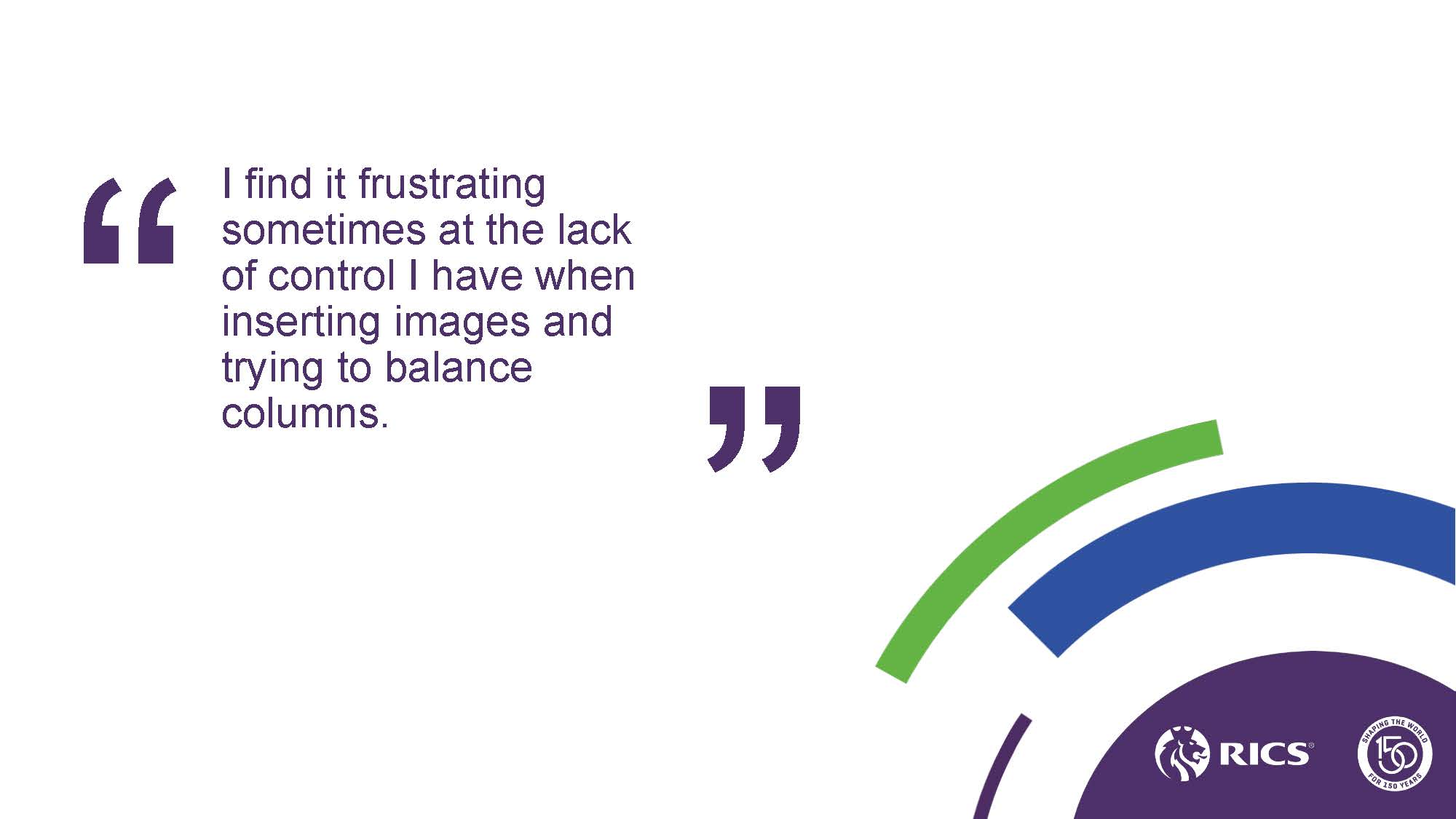
So, hopefully that’s something we can all work on.
In terms of our future plans, we’re quite comfortable with using Typefi for standards and the Insight reports now, but there are other outputs that we might want to have a look at.
Something RICS is really focusing on now is data standards and machine-readable standards, and we’ve got a new edition of one of our massive Rules of Measurement coming up, which is like a 300-page Beano Annual full of landscape tables, which, you know, the future isn’t in books like that anymore.
People want solutions. People want datasets and they want to be able to manipulate the information themselves. We’re hoping that the new Excel feature could really help us with that, so quite excited about that.
Our journals are due to undergo a bit of a redesign at some point in the future, hopefully in the next year. So, there might be an opportunity to bring those into Typefi as well.
As I mentioned before, we do quite a few translations; they’re all done by a translation agency. So, that might be something that we could potentially explore as well.
And one thing we might want to start doing—because the editorial team are fabulous, but very, very busy—we might want to have a look at using some of Typefi’s outsourcing partners to help us stay agile and focus on priorities.
So, yeah, I guess my summary. If I’m to impart any wisdom on anybody looking to implement Typefi in an organisation like ours—and I guess this is where the people in the future might be interested, listening online, so, hello to you—number one is be realistic.
It sounds obvious but I’d never done anything like this before. My boss isn’t a publishing person, so he just kind of left me to go on, get on with it.
I think I was a little bit ambitious. I thought, yeah, a couple of months and this is going to solve all of our problems for us and get me promoted and all the rest of it. But it actually took a couple of years longer than we thought it would and a little bit of extra investment as well.
But do be patient because it is worth it in the long run, I think and I hope. Still trying to convince some of the editors that.
Do make friends with everyone in your organisation. So, the IT team, finance team, procurement, legal. Make sure they know exactly what you need to do, what you want to do, why you’re doing it. Take them on the journey with you and make sure that they actually read the small print, because I think that’s the first problem that we had when we couldn’t get Typefi to work on day one.
Do involve the production team and train super users rather than the whole team in one go. As I said, all the editors all want to do everything and all want to be involved, which is fantastic, but I kind of made a bit of a mistake, I think, in inviting and including them all at the template training and the Writer training.
It was a very intense period of time and some people just weren’t as into it as others and some of them haven’t yet used Typefi at all. So, I say just focus on a few people and they can train the rest.
Number five is to use the Typefi community. So, as part of my due diligence, I think Clive did this too, I did reach out to some of Typefi’s existing customers, which was really helpful. Wish I’d spoken to a few more people.
And yeah, I say events like this are quite precious as well and really, really useful. So, thank you Typefi and keep doing that.
So, I think that’s really it from me. Has anyone got any questions?
ATTENDEE 1: Hello. Do you ever get the InDesign files back to make tweaks like where the columns weren’t balancing, etcetera, or is that the problem, that it goes straight out to your output?
SARAH: No, I think that is a cheat that we do at the moment. Someone correct, Jo’s nodding. So yeah, I think I’m safe to say that.
So yeah, I think we were kind of advised that going back into the InDesign to make those tweaks isn’t great practice but it’s what we’re doing at the moment as an interim measure, I’d say.
ATTENDEE 2: Or we put hard returns into the Word file, to try and get paragraphs working again.
SARAH: Yeah. Which is exactly the problem that we used to have with our XML files, so it’s something that we’re quite keen to solve.
PETER KAHREL: The problems that you described, indexing, column balancing, float placement, and the fourth, I forget which it is, they have been handled and dealt with for several customers. If you have those problems, have you posted support tickets for them?
SARAH: I don’t think we have. I think, as I said, it’s more of a niggle and I think, as editors, we’re quite stubborn in wanting to try and solve the problems ourselves and try and fix them, so this is the feedback that I’m hearing from the team.
I think maybe we do need a refresher because maybe our templates aren’t set up correctly or something like that. So, it’s something that we’re looking into.

Sarah Crouch
Head of Publishing and Content | Royal Institution of Chartered Surveyors (RICS)
Sarah has worked in publishing for 15 years and has experienced various editorial and production roles in legal, academic and professional publishing.
She joined RICS in 2008 and is currently responsible for the institution’s standards, journals, online content and thought leadership outputs. The RICS team has been using Typefi for the standards and guidance portfolio for just over a year.

